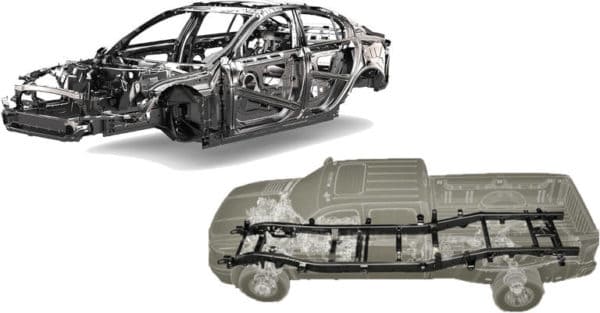How Do You Know If A Car Has Frame Damage

The structural integrity of a vehicle hinges on its frame. More than just a support structure, the frame provides a foundation for handling, safety, and overall performance. Identifying frame damage early is crucial, whether you're a seasoned mechanic, a car enthusiast tinkering in your garage, or simply a concerned owner. This article delves into the telltale signs of frame damage, equipping you with the knowledge to spot potential issues before they escalate.
Understanding Vehicle Frames: A Primer
Before diving into the signs of damage, let's briefly differentiate between common frame types. Historically, many cars and trucks utilized a body-on-frame construction. Think older SUVs and pickup trucks. This design features a separate chassis (the frame) onto which the body is mounted. Conversely, modern passenger cars largely employ unibody construction, where the body and frame are integrated into a single unit. This design offers advantages in weight reduction and structural rigidity, but repairs can be more complex. Some vehicles, particularly SUVs and crossovers, may use a hybrid approach – a modified unibody with reinforced frame elements. Understanding the construction of *your* vehicle is the first step.
Visual Inspection: The First Line of Defense
A thorough visual inspection is often the easiest way to initially detect frame damage. Here's what to look for:
- Rust and Corrosion: While rust is common on older vehicles, excessive corrosion, especially on critical structural members, can indicate underlying weakening and potential frame compromise. Pay close attention to areas around suspension mounting points, body mounts, and welds.
- Bends, Cracks, and Dents: These are the most obvious signs of frame damage. Carefully examine the frame rails (the main longitudinal beams), crossmembers (perpendicular supports), and any other visible frame components. Even seemingly minor dents can indicate a significant impact.
- Misaligned Body Panels: Notice gaps between doors, fenders, hood, and trunk. If these gaps are uneven or excessively large, it could indicate that the frame is twisted or bent. For example, a door that's difficult to close or requires excessive force could be a sign of a compromised frame.
- Damaged Welds: Inspect all welds for cracks, breaks, or signs of repair. These are critical points of structural integrity, and damage to a weld can significantly weaken the frame.
Handling and Performance Clues
Frame damage can manifest in various handling and performance issues. Keep an eye out for these symptoms:
- Uneven Tire Wear: If your tires are wearing unevenly, especially if the wear pattern is unusual (e.g., excessive wear on the inside or outside edges), it could indicate a misalignment caused by a bent frame.
- Difficulty Steering: A bent frame can alter the vehicle's geometry, making it difficult to steer straight or causing the vehicle to pull to one side.
- Vibration or Shaking: Excessive vibration, especially at higher speeds, can be a sign of frame damage affecting the vehicle's balance and stability.
- Poor Alignment: Repeated alignment issues, despite proper adjustments, often point to an underlying structural problem, potentially frame damage. Regular alignment checks are crucial, and if your mechanic notes recurring problems, investigate further.
Professional Inspection: When to Seek Expert Help
While a visual inspection and performance observations can provide clues, a professional inspection is crucial for confirming and assessing the extent of frame damage. Here's when to seek expert help:
- After an Accident: Any collision, even a seemingly minor one, can potentially damage the frame. A professional inspection is essential to ensure the vehicle is safe to drive.
- Suspect Frame Damage: If you notice any of the visual or performance indicators mentioned above, consult a qualified mechanic or body shop.
- Buying a Used Car: A pre-purchase inspection, including a frame check, is a worthwhile investment to avoid buying a vehicle with hidden structural issues.
Professional inspections typically involve using specialized equipment, such as frame alignment machines and laser measuring systems, to precisely assess the frame's geometry and identify any deviations from factory specifications. These tools provide a much more accurate and detailed assessment than a visual inspection alone.
The Cost of Frame Damage Repair
The cost of frame damage repair varies significantly depending on the severity of the damage, the vehicle's construction (body-on-frame vs. unibody), and the labor rates in your area. Minor damage might be repairable with specialized tools and techniques, while more extensive damage may require replacing entire sections of the frame. Unibody repairs often require specialized welding and alignment equipment, potentially increasing costs. Expect to pay anywhere from a few hundred dollars for minor repairs to several thousand dollars for major structural work. In some cases, particularly with older vehicles or severe damage, the cost of repair may exceed the vehicle's value, making it economically unfeasible.
Ultimately, understanding the signs of frame damage and seeking professional help when needed is vital for ensuring your vehicle's safety, performance, and longevity. Whether you're a seasoned automotive professional or simply a concerned car owner, knowledge is your best defense against costly and potentially dangerous structural issues.
